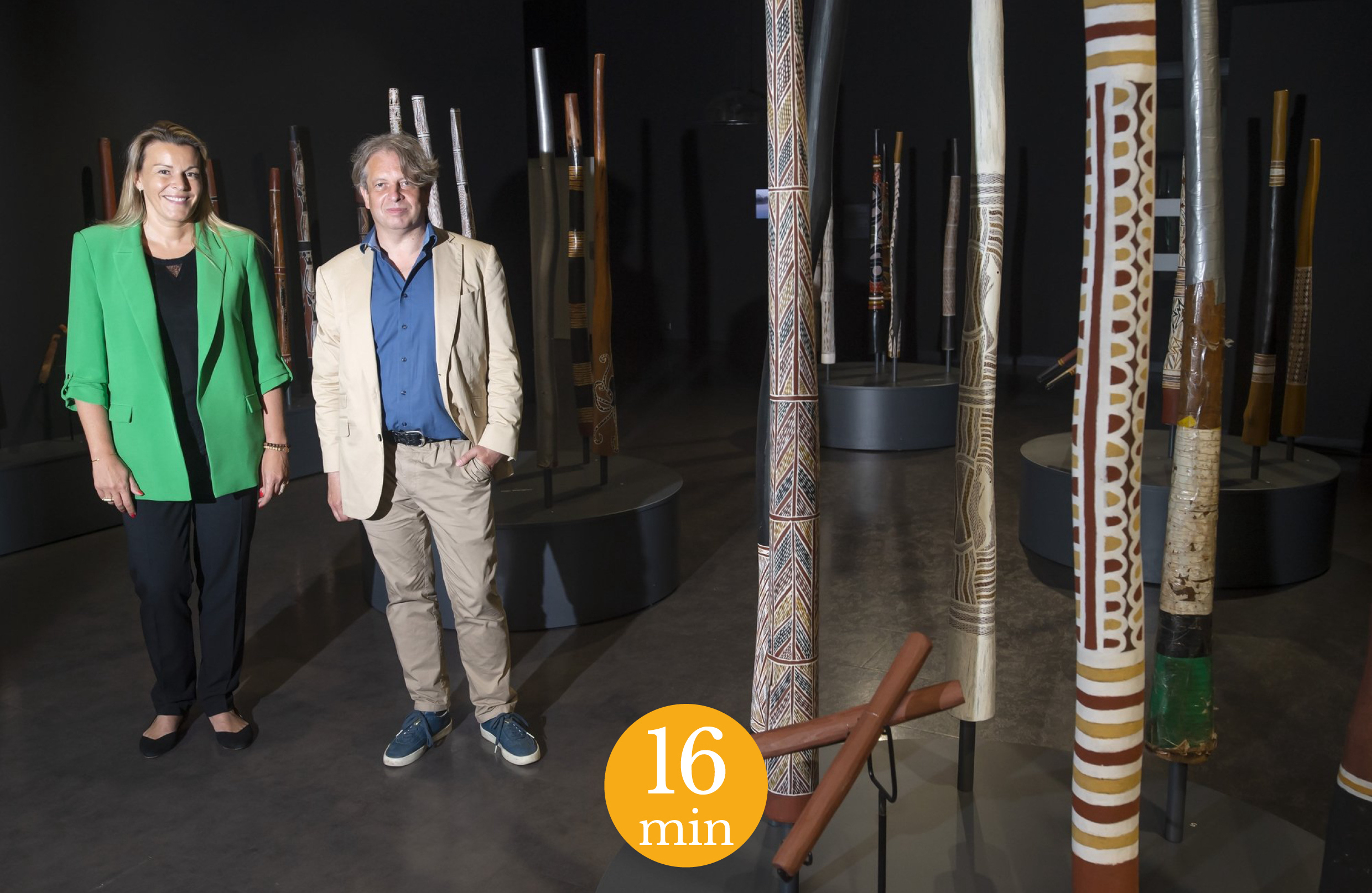The Casoar team respectfully advises Aboriginal and Torres Strait Islanders people that this article includes images, works and names of deceased Indigenous people and may include images of artistic, cultural or intellectual property that may be of sensitive nature.
Elsa Spigolon Welcome, Mr Petitjean! We are thrilled to interview you for CASOAR. In a few words, could you introduce the Fondation Opale, as well as your current position within the institution?
Georges Petitjean : The Fondation Opale is a foundation in Switzerland that was founded in 2018. It is quite recent, and will celebrate its 5th anniversary in December of this year. The Foundation is primarily dedicated to contemporary Aboriginal art. It was founded by Bérengère Primat, who is a French-Swiss collector of Aboriginal art. It is her collection that is the basis of this Foundation. I am the curator of Bérengère Primat's collection, and by extension the curator of the Fondation Opale.
E. S. : How many pieces are there in Bérengère Primat's collection?
G. P. : About 1,500 works; very recently, a fund for the Foundation itself was created, and the institution began to have its own collection. Two years ago, the Friends of the Fondation Opale began contributing to allow the purchase of new works for the collection. Donations are also made to the fund established for the Fondation Opal itself.

View of the Fondation Opale in Lens, Switzerland. Photograph © Fondation Opale
E. S. : What is your personal background? Why Australia?
G. P. : Concerning my personal background, I am an art historian. I am originally from Brussels, I started by doing three years at LUCA School of Arts between 1987 and 1990, where I devoted myself to film and video. then started studying art history here in Brussels with the Vrije Universiteit Brussel (VUB. After four years of study I obtained my master's degree.
After my first two years at the VUB, I went to Australia for the first time, in 1992, with no intention of encountering Indigenous Australian; in fact, it was the opposite, I was looking to take a step back from the art world in Europe, and I simply wanted to experience Australia and its natural richnesses. At the time, I had no knowledge on the subject of Aboriginal art. I wanted to disconnect and have as little to do with art as possible. It was also my first big trip outside of Europe. I went during the summer holidays of 1992. I didn't plan anything (laughs), I didn't booka hotel, and as it was long before the internet I had just seen a video about Australia that I had borrowed from the local library, and read one or two books, but nothing more. The total unknown, I didn't know what to expect.
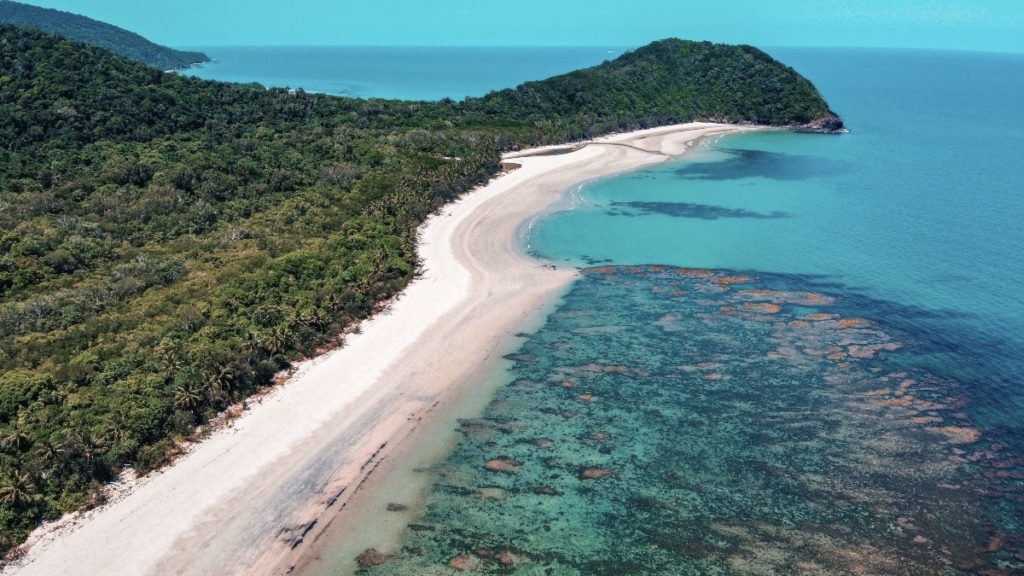
View of Cape Tribulation in Cairns, Australia. Photograph © Australie Guide Backpackers
E. S. During this first trip, have you visited Aboriginal communities?
G. P. : Yes, it happened on that trip. I did a month-long trip, which started in Sydney, then I went up the East Coast, with Byron Bay, Brisbane, and I went up to Cairns in the North. From Cairns, I flew to Alice Springs, and then I travelled from Alice Springs to Darwin, doing a 14 days trip stopping at several places, like Uluru, the famous monolith in the centre of Australia. It was during this trip that I for the first time met Aboriginal people, and that I saw Aboriginal art, in the Northern Territory. I was first introduced to Aboriginal art through the rock paintings in Kakadu National Park. Of course, I had been to the museum in Sydney, but there wasn't much Aboriginal art there. In Alice Springs, I didn't know the right galleries yet, I saw a lot of very touristy stuff, and my very first feeling with contemporary art was that I wasn't totally convinced that it was art with a capital A.
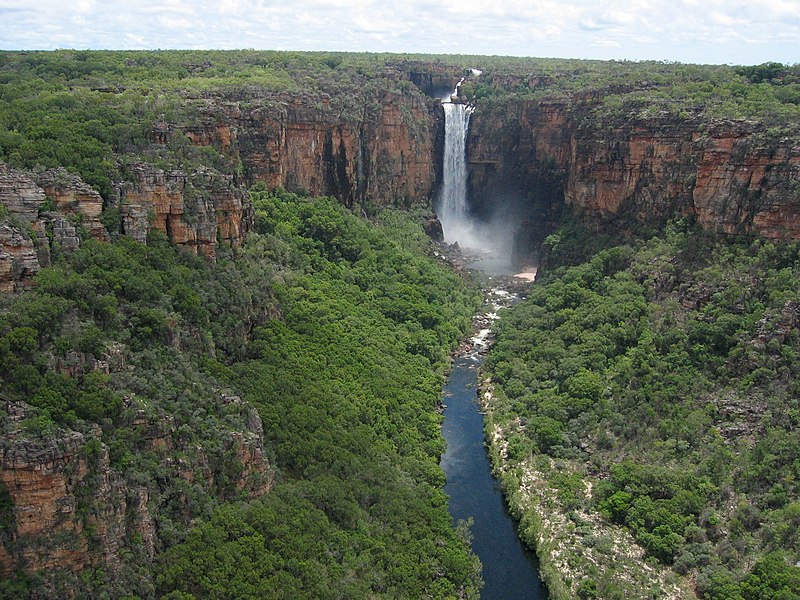
Jim Jim Falls, Kakadu National Park © Nigel Malone
E. S. : So you first feeling was that these creation were rather ordered by big business?
G. P. : A little, yes! In fact, the place where I best discovered Aboriginal art was when I returned to Belgium in 1993, when I had to choose a subject for my thesis (master's degree). To be more precise, before that, for a contemporary painting course that had as a subject "the mythical in contemporary painting", I immediately said to myself that I should work on contemporary Aboriginal art. As I didn't have any books with me, I went to the Australian embassy here in Brussels which, fortunately for me, had a very nice collection of books, and very good ones at that, that I hadn't seen in Australia. It was in these books that I saw some paintings that were breathtaking, fantastic, and where I realized that there was not only art for tourism, that it represented a part of the production but not only, and that there were great artists in contemporary Indigenous Australian art. That same year, I also had to choose a subject for my thesis (master's degree), and I chose again to write about Aboriginal art.
In the summer of 1993, I went for the second time to Australia, and there, specifically, it was to immerse myself in the art. There, I visited all the museums and galleries that held this art in their collections, I went to Alice Springs for two weeks to meet Aboriginal artists and to talk with them, and I had on this occasion the immense pleasure and privilege to talk with people who had begun to paint with the contemporary art movement of Papunya, who had been the very first initiators.
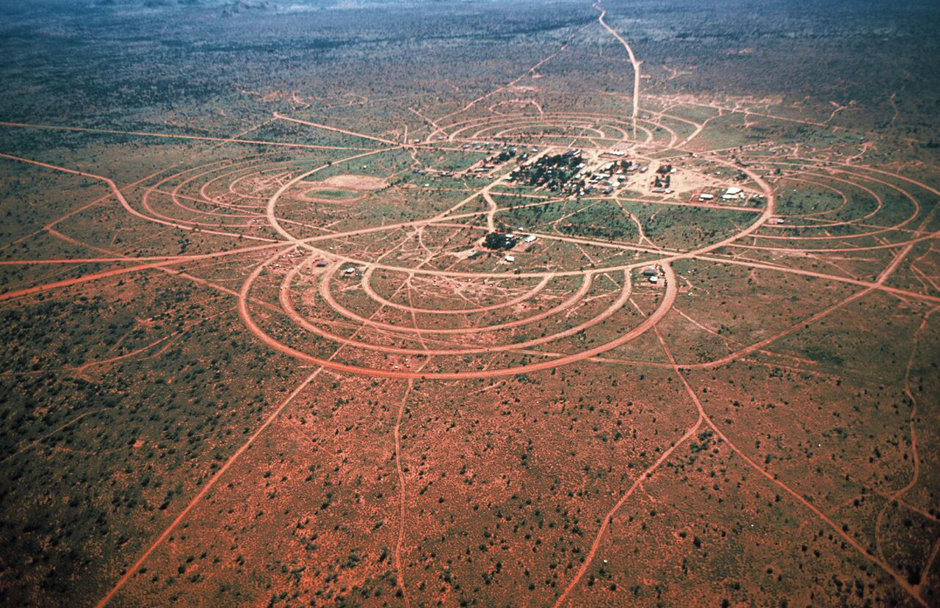
Honey Ant Dreaming streetscape, aerial view, Papunya community. Photographer: Max Stollznow, 1976. Media © ACCA, Australian Center for Contemporary Art
E. S. : How lucky! How old were these people in 1993?
G. P. : In 1993, there were still many people living who had participated in the emergence of the Papunya movement in 1971. Often they were in their fifties, sixties, up to their seventies...these people must have been between 25 and 50 years old when they started painting in Papunya, but there were also older people.
With all this information, I returned to Belgium, wrote my master's thesis on the subject of contemporary painting in the Western Desert of Australia.
Just at that time, in 1993-1994, there was a growing interest in Europe in contemporary Aboriginal art, including a very large exhibition called Aratjara, Art of the First Australians, which was shown at the Kunstammlung Nordrhein-Westfalen in Dusseldorf, among other places, and later went to the Looisianna Museum in Humlebaek, Denmark, and to the Hayward Gallery in London. There were one or two commercial galleries in Belgium that showed Aboriginal art, which also asked me for presentations around 1994-1995. In 1996, there was also a big exhibition of Aboriginal art in Bruges at the Oud Sint-Jan Site.
Alice Springs. Photograph © Evaneos
G.P. In 1995, I returned to Australia for the third time. I visited Melbourne for the first time, and I returned to Alice Springs. In the meantime I had read a lot, especially the publications byGeoffrey Bardon and Wally Caruana. What struck me, going back to the galleries and art centres and seeing great artists that had fascinated me, was that unfortunately nobody seemed interested in Australia in the art. Nobody was researching the great Papunya painters. These artists were even chased out of the galleries! There was little or no academic interest, you could count the few books that existed on the fingers of one hand so to speak. This made me want to spend more time in Australia, to do research, to meet the artists to talk about the art movement. Thanks to several coincidences, I met people working at La Trobe University in Melbourne, who introduced me to some professors and anthropologists. With all this knowledge, I went back to Belgium and started exploring possibilities to go back to Australia as soon as possible, and stay there longer, several years even. I wrote to Australian universities with the aim of writing my doctoral thesis, and the answer was always the same: "It's very interesting, Aboriginal art, but we can't help you because Aboriginal art is not included in the art history curriculum." It wasn't perceived as art history. No university in Australia in the mid-1990s seemed to see Aboriginal art as art. I had two universities, the National University of Australia in Canberra and La Trobe University in Melbourne, who told me that I could get enroll, with a scholarship, but that no one could be my art history promoter because it was just not a subject. I was advised to write my doctorate in the Anthropology and Sociology department. That's what I ended up doing at La Trobe University, not being a sociologist or an anthropologist. Melbourne was a better place to settle than Canberra because there were more galleries showing Aboriginal art. There were also the big auction houses, like Sotheby's, which were just starting to show Aboriginal art. So I had to find a sociological or anthropological twist to my art history subject: I decided to study the journey of contemporary Aboriginal artworks, from their place of production in the Central Desert to the moment they are shown on the walls of an exhibition space, in Belgium, elsewhere in Europe or in the United States. What interested me was the change in context, the change in the way people look at the work, and how it differs from the artist's own look. My promoters were not specialists in Aboriginal art: the closest to my subject was a specialist in Papua New Guinea. Then, when he retired, I had two other promoters, also eminent researchers: one of them was a specialist in ancient Greek vases with red figures, and the other knew Byzantine mosaics by heart (laughs). That says something about Australia and the perception of Aboriginal art. It was only in 1998 that for the first time Aboriginal art was included in the art history courses of some universities. It is unthinkable today, but it took time!
E. S. : How long have you been working for the Fondation Opale?
G. P. : I've been working for the Fondation Opale since the very beginning, in 2018, but I've been working with Bérengère Primat's collection since 2017. However, this collection started much earlier, in 2005. I have known Bérengère Primat since 2005 as well.
Mes études en Australie ont repris pour mon doctorat donc. Je m’étais installé à Melbourne depuis février 1997, pour y rester jusqu’en novembre 2002. Je partageais mon temps entre ma ville et Alice Springs, d’où partaient des excursions qui me permettaient de rencontrer régulièrement des communautés Aborigènes qui vivaient à l’écart de cette ville. Entre 2002 et 2005, j’ai fait de nombreux allers-retours, et en septembre 2005 je suis devenu le conservateur du seul musée d’art Aborigène en Europe, qui était à Utrecht aux Pays-Bas. Ce musée a été fondé en 2001 et a dû fermer ses portes en 2017. J’y étais donc le conservateur durant presque 12 ans, jusqu’en juillet 2017. C’est dans ce contexte que j’ai rencontré Bérengère Primat. Nous avions une connaissance commune depuis la fin des années 90, également passionnée d’art Aborigène, et j’ai rencontré Bérengère Primat le même mois durant lequel j’ai été nommé conservateur à Utrecht. Par la suite, je lui ai demandé à plusieurs reprises des œuvres de sa collection en prêt. Elle est venue à plusieurs vernissages au musée.
Towards the end of my curatorial role at the museum, so in 2017, Bérengère had already contacted me about her collection, so that I could see it and we could consider making a publication about it. That was our very first project.
Regarding the Fondation Opale itself, Bérengère Primat lives in Crans-Montana, in the Alps in Switzerland, and nearby was established the Fondation Pierre Arnaud that was dedicated to Swiss landscape paintings, in their very beautiful and ambitious building built in 2013. Around 2017, this foundation approached Bérengère Primat to see if she was interested in an exhibition with art from her collection, which she was. During the duration of the exhibition, which was called Territoire du rêve (Country of the Dreaming)we learned that major financial difficulties would soon lead to the permanent closure of the Fondation Pierre Arnaud, and that this exhibition would be the last. The town of Lens in the Valais then approached Bérengère Primat with the idea of taking over this imposing building, and that is how the Fondation Opale was born. It was inaugurated very early , so that the Foundation could take advantage of the high of winter season from December to Easter. The very first exhibition was realised in collaboration with Yann Arthus Bertrand, and showed his photographic work. Aboriginal art was produced in the following exhibitions. Since then, the collection and the Foundation have continued to grow!
E. S. : What is the nature of your professional relationship with Ms. Primat? What exactly is her role in the selection process of the artists and the works exhibited?
G. P. : Bérengère Primat is the President of the Foundation and its Board of Directors. But she is more than simply that, as she is also personally and very proactively involved in Aboriginal art. Our professional relationship is now long-standing, and from the beginning we have been in a common synergy which is well reflected in the selection process of the artists and the works exhibited. The choice is made together, in a balanced and organic way, with exchanges of opinion between us. Bérengère Primat is very eager to learn about the subject of Aboriginal art, and we always discuss at a very high level. Finally, it is not so much working for her as working with her. My role, in fine, is to advise her in her choices. in fine, est de la conseiller dans ses choix.
E. S. : Do you choose the exhibition themes together?
G. P. : Often, but it depends on each case! Some exhibitions already existed in another form and we took them over and adapted them to the Foundation's spaces. Others originated with an idea from Bérengère Primat or me, but we always work together. There are no fixed rules about our respective roles. However, obviously, the Fondation Opale is Bérengère Primat's project, and in this sense, my role is to help her where I can, to be a support with my knowledge and my background.
To select the artworks, it also follows a very organic process, the suggestion can come from me or from her. For example, "Have you seen this work? Maybe it would be interesting for the collection…".
E. S. : Are you often in symbiosis on your proposals?
G. P. : Fortunately, yes! Bérengère has a very good eye. Well, if I say that, people will think I'm self-congratulatory (laughs), but she is very enlightened and our joint conversations are always fascinating. We often have the same ideas and views. She is, of course, the final decision maker and I advise her.
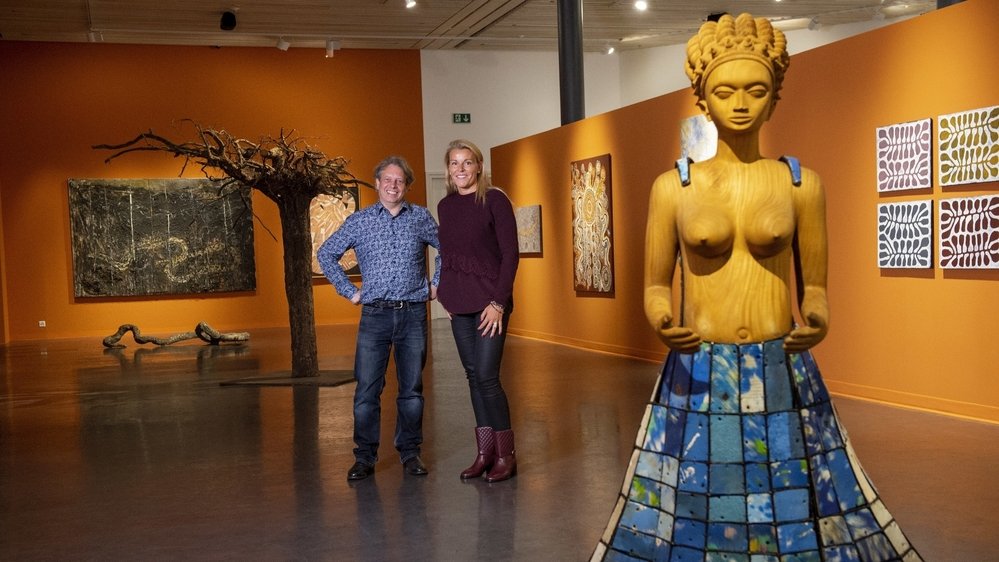
Georges Petitjean and Bérengère Primat in the space of the Fondation Opale, in Lens, on the occasion of the exhibition Résonances, from June 2020 to April 2021. Photograph © Le Nouvelliste (https://www.lenouvelliste.ch)
E. S. : What exhibitions are currently on display at the Fondation Opale?
G. P. : There is currently a major exhibition at the Fondation Opale, entitled Dreaming in the Dream of Others, which runs until April 16, 2023. It's an exhibition that includes works by the French artist Yves Klein and works by several Aboriginal artists. We also have a smaller exhibition, our "Special Focus", in which we always present the work of a particular artist. We are currently using this space to present the work of Ulay, once Marina Abramovic's partner . He spent considerable time in Australi time and worked on photographic projects with Aboriginal people in the centre of the country. For Dreaming in the Dream of Others, there are three curators: Bérengère Primat, myself, and Philippe Siauve, who worked for a long time on Yves Klein's archives and who found some of the artist's drawings dating from the 1950s in which we can see that he was inspired by the Aboriginal art he saw in books.
E. S. : Is this what is behind this exhibition project?
G. P. Indeed! We already knew Philippe Siauve because he had worked on the catalogue of Territoire du rêve (Country of the Dreaming). In his archival work, he had spotted a drawing by Klein in which a kangaroo could be recognised. I subsequently contacted a friend of mine, a former curator of the National Gallery of Australia, who fortunately knew about this drawing because he had seen it in a publication from the 1930s! Then a great deal of art historical work began with several people and in collaboration with the Yves Klein Archives, and that's how this project was born.
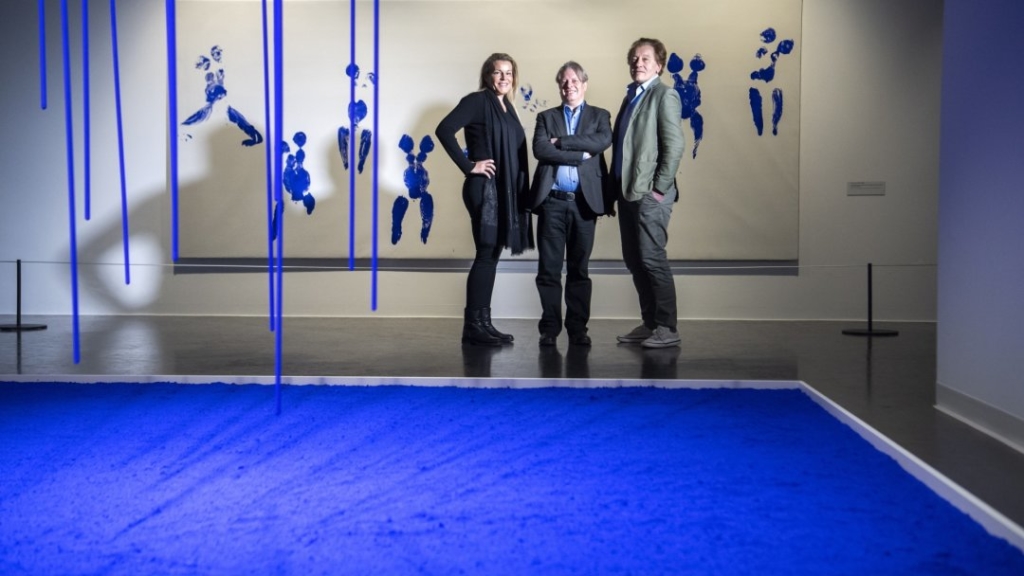
Bérengère Primat, Georges Petitjean and Philippe Siauve in the space of the Fondation Opale on the occasion of the exhibition Dreaming in the dream of others, from December 2022 to April 2023. Works: Pigment pur bleu and Pluie bleue by Yves Klein. Photograph © Le Nouvelliste (https://www.lenouvelliste.ch)
E. S. : Are the works of Aboriginal art that you choose for your exhibitions new works?
G. P. : We have commissioned works for many of our exhibitions. For the current show, a number of works come from the collection that we've already built up, but there is a large nine-panel work by Danie Mellor that I saw in Melbourne and that we bought for the show because it offered a perfect dialogue with the subject of the show. We often take advantage of happy coincidences! The exhibitions and the works that will be shown in them happen, as I said before, in a rather organic way. This is the main difference between the Fondation Opale and the process of large institutions, which usually prepare their exhibitions many years in advance.
E. S. : A small team, but composed of people who know each other very well and who like to work together!
G. P. : Absolutely! It has advantages and disadvantages, because once the exhibition has to be realized, it's a huge job to be divided between a few people.
E. S. : Votre œuvre favorite de l’exposition présentée en ce moment, en quelques mots ?
G. P. : Pour rester dans le domaine de l’art Aborigène et ne pas parler des œuvres d’Yves Klein, et si je devais n’en retenir qu’une…je pense qu’il s’agit d’une œuvre de Judy Watson intitulée shiver. The artist has both Aboriginal and Anglo-Saxon ancestry; her mother was Aboriginal. Judy Watson was already, as a child and through her grandmother, confronted with the stories of massacres that took place in Queensland against Aboriginal people. Many massacres were perpetuated in order to steal the land to put cattle on it.
Judy Watson, shiver, 1993, oxide on calico,
195 x 102 cm. Work from the collection of the Opale Foundation - Bérengère Primat. Photograph © Sotheby's
E. S. To remind our readers: the first contacts of the First Australians with the white world are sometimes very violent and begin in the 17th century, with the navigator Willem Janszoon in 1606, then with the Dutchman Jan Carstensz, in 1623. The Dutch then settled in the port of Makassar, Indonesia where a Rajah was installed. The port became very important by trading with Europe and China, for example for the export of sea cucumbers. From this time onwards and throughout the 18th and 19th centuries, white populations of Anglo-Saxon origin spread into the Australian interior, which until then had been inhabited by a population of about 300,000, divided into numerous small groups speaking about 600 languages. There was a sharp and catastrophic decline in the Aboriginal population from this time onwards: since Australia had been wrongly declared de facto " terra nullius » (« terre vide ») par les colons, la terre était utilisée par la population nouvelle pour faire paître du bétail au détriment de la population aborigène, et a conduit à de terribles chasses à l’homme et à de violents combats entre les fermiers et les Aborigènes. Les enjeux étaient également dûs à l’importante quantité de métal et de minéraux précieux dans le sol australien, du diamant au zinc. Les droits civiques des Aborigènes ne furent reconnus qu’en 1967, date jusqu’à laquelle ils n’avaient pas le droit de circuler. En 1976, le droit à la propriété du sol des grandes communautés aborigènes situées dans le Nord du continent (par exemple en Terre d’Arnhem) fut enfin reconnu.
G. P. : There are well known stories from that time that tell of settlers poisoning the water. The last large massacre in Australia took place in 1928. There is more and more talk about it.
E. S. : There was also the phenomenon of the Stolen Generation ; Aboriginal children of mixed blood were taken from their families and placed in white families in order to integrate them into the population.
G. P. : The common idea at the time was that Aboriginal culture was fossilised and would disappear in the following decades, and that it was necessary to assimilate the Aboriginal people with the white Anglo-Saxon population. One of the strategies was to take children of mixed blood from their mothers and place them in orphanages that were a very long distance from their birthplace. They were then re-educated, with punishment mechanisms if they still spoke their own language. In the 1930s, it went even further: the discourse was that by marrying Aboriginal people with white populations, their dark skin color would eventually fade.
L’ œuvre de Judy Watson présentée en ce moment à la Fondation Opale, shiver, is a linen canvas partially covered with red ochre. It reminds me of the Shroud of Turin; it's as if this canvas had wrapped around the body of someone who was murdered, whose blood is equated in the work with ochre. It dialogues very well with Yves Klein's Anthropométries , with a very special blue, which responds to the red that is associated in Aboriginal culture with the blood of the ancestors.
E. S. : With which communities or art centres do you work with? How are the artists and works selected for the Foundation's permanent collection?
G. P. : La collection présente des œuvres de l’Australie entière ; beaucoup d’artistes ont un héritage mixte, à l’image de Judy Watson. Les œuvres sont dans plusieurs médias : photographies, installations, peintures sur écorce, peinture à l’acrylique sur toile…dans plusieurs cas, comme c’est le cas pour les artistes occidentaux, les artistes sont représentés par des galeries que nous connaissons. Nous connaissons la plupart des artistes d’un point de vue personnel, mais nous passons quand même par les galeries, ou pour certains artistes par les centres d’art. Pour l’art aborigène, la provenance est très importante. Une provenance éthique permet de s’assurer que les artistes des communautés éloignées, non représentés par des galeries mais par des centres d’art, soient bien rémunérés. Les centres d’art sont souvent soutenus par le gouvernement, et les artistes en sont les actionnaires. La personne qui gère le centre, qui a souvent fait des études d’art, fait l’intermédiaire entre les artistes qui ne sont pas en contact avec le monde de l’art et les personnes qui souhaitent acquérir leur art, par exemple les galeries et d’autres encore. Ces artistes ne parlent en général pas très bien anglais, un intermédiaire qui s’assure de leur rémunération est donc très important. Un exemple de centre d’art serait le Buku-Larrnggay Mulka Centre à Yirrkala, en Terre d’Arnhem. Nous les visitons souvent.
E. S. : When will you return to Australia?
G. P. : Oh, I just got back! The rate we go is at least once a year, but in 2018 for example we went three times.
E. S. : Could you explain the genesis of the exhibition Before Time Began presented at the Museum of Art and History in Brussels?
G. P. : The exhibition opened in October 2021, and ran until May 2022. For the most part, this exhibition was presented at the Foundation, but for the Musée du Cinquantenaire in Brussels it was expanded. I had chosen for the epilogue the work of Michael Cook, and for the entrance an introduction on material and immaterial culture, with the importance of managing the land. Starting with a video with news clips of the gigantic fires that ravaged Australia in the summer of 2019 was a way to introduce to the general public a fundamental aspect of Aboriginal culture, namely the stewardship of the land and the intrinsic link that exists between humans and country For a long time, people wanted to believe that Aboriginal peoples had no culture. This way of thinking was of course a good excuse to take their land, since the idea was wrongly conveyed that they did not do anything with it. However, Aboriginal peoples had a very sophisticated way of managing the land, in order to avoid that these big fires would start accidentally! Aboriginal people incited fires and controlled them, regenerating the land in the process. The fires that we have seen recently in the South-East of Australia, not far from Sydney, is also the region where the first settlers came, and therefore the region most affected by colonialism, and where the absence of the original inhabitants was most felt in relation to their management of the land for 150 years. In some places, it is said that there was up to a metre to a metre and a half of very dry wood that was just waiting to catch fire. Of course, the climate also plays an important role. So our idea was to provoke a sudden reversal of the concept that Aboriginal people did not manage the land. The main part of the exhibition was, in fact, the first major exhibition of Aboriginal art to be presented in 2019 at the Fondation Opale after its inauguration in 2018! Being from Brussels, many of my friends and colleagues worked in Belgian museums and at the Cinquantenaire, and we were able to organise this exhibition by talking to them. As a Belgian, this was something very important to me.
E. S. : Your favorite work that was presented there, in a few words?
G. P. : My favorite work from this exhibition is Kulata Tjuta - Kupi kupi / Many Spears – Whirlwind. It has been commissioned for the Foundation in 2019.
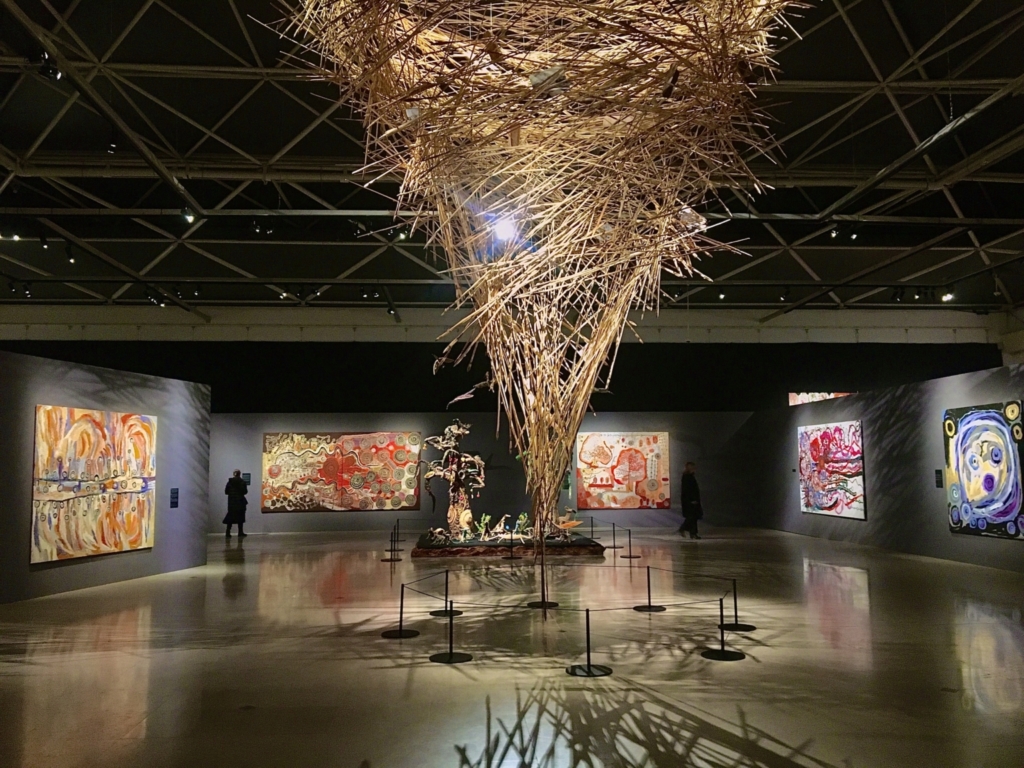
Artists from APY country, South Australia. Kulata Tjuta - Kupi kupi / Many spears - Whirlwind, 2019. Spears (1500) and wooden objects, photographs. Work in the collection of the Fondation Opale - Bérengère Primat. View from the exhibition Before Time Began presented at the Art & History Museum in Brussels, Belgium, between October 2021 and May 2022. Photograph © Elsa Spigolon
E. S. : A final word on your future ambitions, within the Foundation or elsewhere?
G. P. : As far as the Foundation is concerned, Bérengère Primat is someone who is very committed, who does not look at the short term but at the long term. I hope to be able to continue with her for many years to come and to create beautiful exhibitions. A new building will open in December 2023 at the Foundation, doubling its surface area. This building will house an archive, a library, an auditorium, in order to make it a real platform to continue to highlight Aboriginal culture, on the same level as any other art in the world. That's why the exhibition that also shows the art of Yves Klein is very important, so that Aboriginal art is shown and perceived as equal to any other art. The exhibition will be open until April 16!
Elsa Spigolon
Header: Georges Petitjean and Bérengère Primat in the space of the Fondation Opale, in Lens, on the occasion of the exhibition Breath of Life – La vie n’est qu’un souffle, from June 2021 to April 2022. Photograph © Le Nouvelliste (https://www.lenouvelliste.ch)
